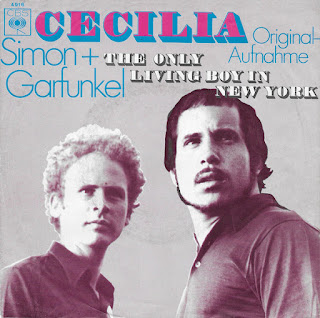SIMON & GARFUNKEL - CECILIA / THE ONLY LIVING BOY IN NEW YORK
Released: April 20, 1970
Charted: US: #4
"Cecilia" released in April 1970, emerged as the third single from the duo’s acclaimed album "Bridge over Troubled Water." Paul Simon crafted the song after a late-night gathering where the duo and friends improvised percussion by banging on a piano bench. Capturing the spontaneous rhythm with a tape recorder, they enhanced the sound with reverb. Simon then composed the guitar line and penned lyrics reflecting on the theme of an unreliable lover.
"Cecilia" portrays the story of a man whose girlfriend leaves him, as depicted in the lyrics "I got up to wash my face, when I come back to bed someone's taken my place." The song later suggests a reconciliation with lines like "Jubilation, she loves me again." Paul Simon clarified that the lyrics should not be overanalyzed, emphasizing the spontaneous nature of the song's creation. He explained that the song stemmed from a rhythmic recording session and the lyrics were improvised to fit the mood, describing it as a "little piece of magical fluff" that just worked.
The reference to Cecilia as the patron saint of musicians adds an interpretation to the song. It can be seen as the singer seeking musical inspiration and guidance, possibly in the context of songwriting. While Paul Simon couldn't recall the exact inspiration behind the song, he acknowledged Cecilia's association with music, suggesting a subconscious influence in the song's creation.
The creation of the rhythm for this track, as described in the liner notes of Paul Simon's Anthology album, is quite unconventional. Paul and Art used a combination of slapping their thighs, Eddie Simon thumping a piano bench, and a friend named Stewie Scharff strumming a guitar with slackened strings. This impromptu session took place at a house on Blue Jay Way during the summer of 1969, not long after the tragic Charles Manson murders nearby. They captured the rhythm using a Sony reel-to-reel tape recorder, with a particularly impressive 1:15 section that they later looped in the studio, a challenging task in 1969 requiring manual tape cutting and looping. With added reverb from producer Roy Halee, this home recording provided the basic backing track for the song.
Clive Davis, the president of Columbia Records, made the strategic decision to release "Bridge Over Troubled Water" as the first single from the album, despite the expectation for catchy, upbeat songs to typically lead albums. This unconventional move proved to be a stroke of genius, as "Bridge Over Troubled Water" soared to the top of the charts, spending six weeks at #1 and propelling the album to similar success. Consequently, "Cecilia" was subsequently issued as the second single from the album.
Simon & Garfunkel's original 1970 single of "Cecilia" failed to chart in Britain. In 1996, Madness lead singer Suggs collaborated with vocal duo Louchie Lou and Michie One on a cover of the song, which managed to reach #4 on the UK charts, marking the only time "Cecilia" made it into the Top 75 in Britain.
"The Only Living Boy in New York" is the eighth track from their iconic album "Bridge over Troubled Water." Initially released as the B-side to the single "Cecilia," the song stands out for its heartfelt lyrics and evocative melody.
This track serves as a poignant reflection of Paul Simon's feelings of loneliness and separation from his partner, Art Garfunkel, during the latter's time in Mexico filming "Catch-22." Simon wrote the song while Garfunkel was away, expressing his frustration and sense of isolation as he worked on the “Bridge Over Troubled Water” album in New York.
The interpretation of "Tom" representing Art Garfunkel in the lyrics adds depth to the song's meaning, symbolizing their journey from their early days as the duo Tom and Jerry to their present state of seeking personal and artistic freedom. Simon's encouragement for "Tom" to let his honesty shine reflects their close bond and shared musical journey. The use of background vocals, with Garfunkel and Simon recorded together in an echo chamber, further enhances the emotional resonance of the song.
The period leading up to and following the release of "Bridge over Troubled Water" marked a significant transition for Simon & Garfunkel. As their partnership faced strains and ultimately dissolved, Paul Simon ventured into his solo career while Art Garfunkel pursued acting opportunities.














Cap comentari:
Publica un comentari a l'entrada